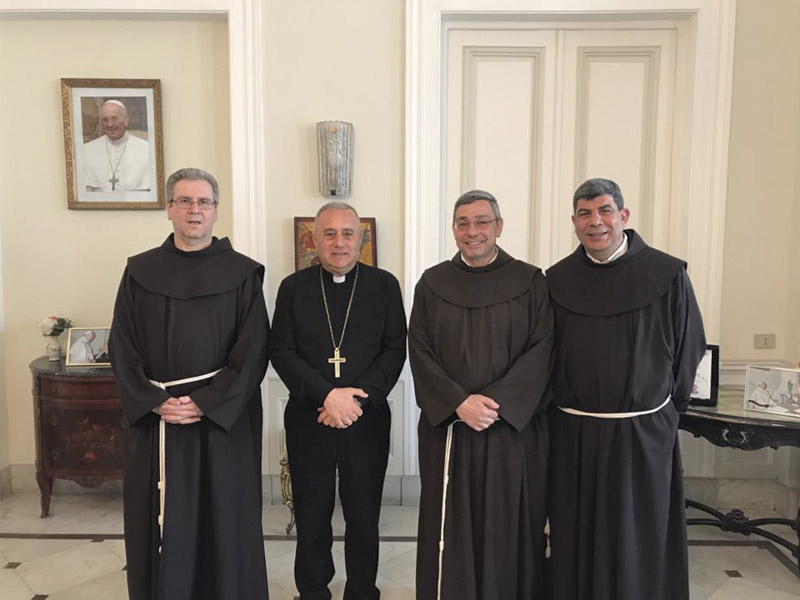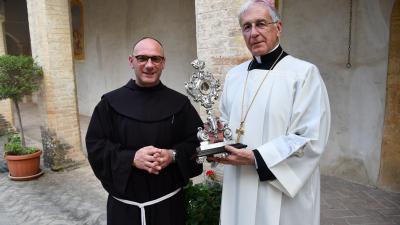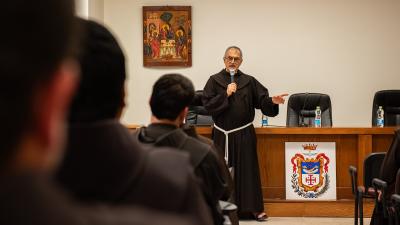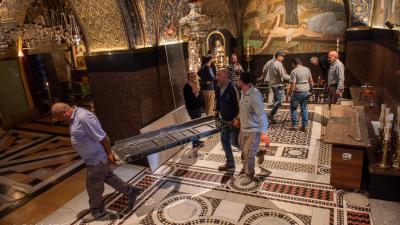
One year after the election as Custos of the Holy Land, Fr. Francesco Patton, concludes his tour the of Custody’s Fraternities. The Muski Monastery in Egypt was last visited by the Custos on his trip just days before the Pope’s arrival. “It was his first visit to our Muski convent, where we also have the parish of the Assumption and the Study Center,” said Fr. Mamdouh Chehab Bassilios, Guardian of the Cairo Fraternity. The Center of Eastern Christian Studies is one of the hallmarks of the Custody that is not often spoken about but that that the Custody plans to revive. “At the Study Center, the fathers of the Church are studied by both Christian and Muslim students,” explained Fr. Mamdouh. There are completely veiled women, sitting next to our friars, like Fr. Vincenzo Mistrih, who translate texts from Latin to Arabic.” Fr. Mamdouh is the guardian, the bursar, the director of the Study Center and the parish priest of the parish of the Assumption: “I told the Father Custos that the center carries on thanks to its past reputation and that at present three of our five friars are involved in teaching [there].”
THE CUSTOS IN EGYPT
In Cairo, the Custos also visited the Apostolic Nuncio in Egypt, as Fr. Ibrahim Faltas tells us, who accompanied him in his tour: “It was a nice encounter. Although the Nuncio was very busy with the Pope's imminent visit, he welcomed us and met the Custos. Fr. Kamal Labib, the provincial minister of Egypt, accompanied us throughout our trip.”
The following day, there was a meeting with the Latin bishop, Mons. Adel Zaki, also a Franciscan, whom the Custos met for the first time. “We also visited Catholic Coptic Patriarch Ibrahim Sidrak, who was in charge of preparations for the Pope’s visit,” said Fr. Ibrahim Faltas. We talked about the Franciscans and preparations for Holy Father’s visit. We also discussed the attacks that deeply affected the country a few months ago.”
The Custos and Fr. Ibrahim then stopped at St. Joseph’s Monastery, where the largest church in Cairo is located, for lunch with the friars. After the Chapter with the fraternity, they moved to Alexandria, to the St. Catherine’s Monastery, the largest monastery in Alexandria. The last stop before their departure was the Sacred Heart Monastery in Ibrahimia. “In the streets we could already see the signs welcoming the Pope and that the whole country was waiting [for his visit],” said Fr. Ibrahim. On the following day, April 28, in fact, Pope Francis arrived in Egypt.
THE POPE IN EGYPT
During the two days of of his stay, the Pontiff met with the President of the Egyptian Republic, the Great Imam of Al-Azhar, Pope Tawadros II, and the Egyptian bishops. He then celebrated a mass at the Cairo military stadium, filled with faithful. “The mass was the happiest and most well attended event that Egypt experienced during the Pope’s visit. The Holy Father transformed the stadium into a roofless church. “Try to imagine,” said Fr. Mamdouh. “We are in a Muslim-majority country. When two or three people gather in a house to pray together, especially in Egypt, they always come across someone who disturbs them. They even get chased out of neighborhoods just because they prayed to Christ. When we are in front of a mass with 25,000 people in a stadium, it is a miracle. “The guardian friar of the Muski fraternity participated directly, working with the liturgical commission that was in charge of the liturgy and he read some little introductions at certain moments during the mass. “The Egyptians welcomed the Pope with great warmth. I heard sounds that are usually made at weddings, like when women make their tongue vibrate to express their joy,” said Fr. Mamdouh.
According to Fr. Ibrahim Faltas, one of the most significant signs of the Pope’s trip was the signing of the document with Pope Tawadros in which he states that there will be no need to “repeat a baptism administered by one of our Churches for anyone who wishes to join another.”
CHRISTIANS IN EGYPT
Today, the Christian community in Egypt is suffering greatly due to repeated attacks. At the numerical level, the Christian presence is mostly Coptic: Orthodox Copts, who were once called monophysites. Among the Eastern churches, there are also Syriacs, Ethiopians, Armenians and Eritreans. There are also Copts in communion with the Church of Rome, who are called Catholic Copts, and they welcomed the Pope. Fr. Mamdouh explained: “Of a total 93 million Egyptians, it is said that 10 percent are Christians but after the 2011 Revolution, many Copts moved away seeking exile and so the presence of those Christians must still be verified.”
Beatrice Guarrera




